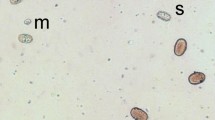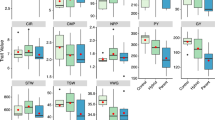Abstract
The experimental study was conducted during the period of 2008–2010 at the experimental field of the Institute of Forage Crops in Pleven. The hybridization scheme included direct and back crosses covering four varieties of forage pea (Pisum sativum L.), namely two spring ones, Usatii 90 and Kamerton from Ukraine, and a winter one from Bulgaria, Pleven 10. There was analyzed the inheritance of quantitative traits such as plant height, height to first pod, pod number per plant, seed number per plant, seed number per pod, seed weight per plant and number of fertile nodes per plant of parental components (P1 and P2) and both first (F1) and second (F2) hybrid generations. The cross Usatii 90 × Pleven 10 showed the highest real heterosis effect for plant height (8.26%), pods per plant (158.79%), seeds per plant (272.16%), seeds per pod (42.09%), seed weight per plant (432.43%) and number of fertile nodes per plant (117.14%). The cross Pleven 10 × Usatii 90 had the highest real heterosis effect height to first pod (11.06%). In F2 plants, the strongest depression for plant height (5.88%), seeds per plant (57.88%), seeds per pod (55.93%) and seed weight per plant (55.99%) was in the cross Usatii 90 × Pleven 10, for height to first pod (1.47%) in the cross Kamerton × Pleven 10 and for number of fertile nodes per plant (15.91%) in the cross Pleven 10 × Usatii 90. The highest positive degree of transgression for number of fertile nodes per plant (165.64%) and seed weight per plant (162.10%) was in the cross Pleven 10 × Kamerton and for pod number per plant (102.54%) and seeds per plant (99.13%) in Kamerton × Pleven 10. The stability of the characters was determined. Low variability in F1 and F2 was found in plant height (3.97–6.85%). Variability of number seeds per plant in F1 was highest (11.86–33.23%). For all other traits, the variability varied from average to high. A lower narrow-sense heritability coefficient was observed for plant height, height to first pod, pods per plant, seeds per plant and seed weight per plant (from 0.001 to 0.230). In few cases, such as in fertile nodes per plant (0.39 and 0.81) and seeds per pod (0.44), the coefficients of broad-sense heritability were higher.
Similar content being viewed by others
References
Popova, Y., Inheritance of Quantitative and Qualitative Traits upon Crossing between Normal and Aphila Cultivars of Pea (Pisum sativum L.), Genet. Sel., 1991, vol. 5, pp. 313–320.
Kalapchieva, S., Breeding Rating of Garden Pea Samples, PhD Thesis, Plovdiv: Maritsa, 2008.
Singh, K.N., Santoshi, U.S., and Singh, H.G., Genetic Analysis of Yield Components and Protein Content in Pea, Indian J. Agric. Sci., 1986, vol. 56, pp. 757–764.
Srivastava, C.P. and Singh, R.B., Genetic Analysis of Seeds per Pod in Peas (Pisum sativum L.), Vegetable Sci., 1988, vol. 15, pp. 38–48.
Parmar, B.S. and Godawat, S.L., Heterosis and Combining Ability in Pea (Pisum sativum L.), Int. J. Tropical Agric., 1990, vol. 8, pp. 19–22.
Singh, M.N. and Singh, R.B., Genetics of Seed Number and Seed Weight in Pea, Indian J. Pulses Res., 1991, vol. 4, pp. 165–167.
Kumar, S., Singh, K.P., and Panda, P.K., Combining Ability Analysis for Green Pod Yield and Its Components in Garden Pea (Pisum sativum L.), Orissa J. Hortic., 1996, vol. 24, pp. 21–25.
Sood, M. and Kalia, P., Gene Action of Yield-Related Traits in Garden Pea (Pisum sativum L.), SABRAO J. Breed. Genet., 2006, vol. 38, pp. 1–17.
Beeck, C.P., Wroth, J., and Cowling, W.A., Additive Genetic Variance for Stem Strength in Field Pea (Pisum sativum), Aust. J. Agric. Res., 2008, vol. 59, pp. 80–85.
Ceyhan, Er., Avci, M.A., and Karadas, S., Line Tester Analysis in Pea (Pisum sativum L.): Entification of Superior Parents for Seed Yield and Its Components, African J. Biotechnol., 2008, vol. 7, pp. 2810–2817.
Dimova, D. and Marinkov, E., Opitno delo s biometriya (Experimenting and Biometry), Sofia: Zemizdat, 1999.
Omarov, D.S., Towards the Methods of Plant Heterosis Recording and Assessment, S-kh. Biol., 1975, vol. 10, pp. 123–127.
Romero, G.E. and Frey, K.J., Inheritance of Semi Dwarfness in Several Wheat Crosses, Crop Sci., 1973, vol. 3, pp. 334–337.
Voskresenskaya, G.S. and Shpota, V.I., Traits’ Transgression in Brassica Hybrids and a Method of Its Quantitate Assessment, Dokl. Vses. Akad. S-kh. Nauk imeni Lenina, 1967, vol. 7, pp. 18–20.
Konstantinov, G., Belcheva, R., Ralchev, K., and Enova, G., Rakovodtsvo za prakticheski zanyatiya po genetika (Practical Manual of Genetics), 1979, pp. 173–178.
Bilgili, U., Sincik, M., Uzun, A., and Acikgoz, E., The Effects of Supplemental Lighting and Light Density on Plant Growing of Pea (Pisum sativum L.) in Greenhouse Conditions, 4th Turkey Field Crops Congress, 2001, 2001, pp. 117–121.
Author information
Authors and Affiliations
Corresponding author
Additional information
The article is published in the original.
Rights and permissions
About this article
Cite this article
Kosev, V., Pachev, I., Angelova, S. et al. Inheritance of quantitative traits in crosses between two Pisum sativum subspecies with particular reference to their breeding value. Russ J Genet 48, 41–46 (2012). https://doi.org/10.1134/S102279541111010X
Received:
Published:
Issue Date:
DOI: https://doi.org/10.1134/S102279541111010X




